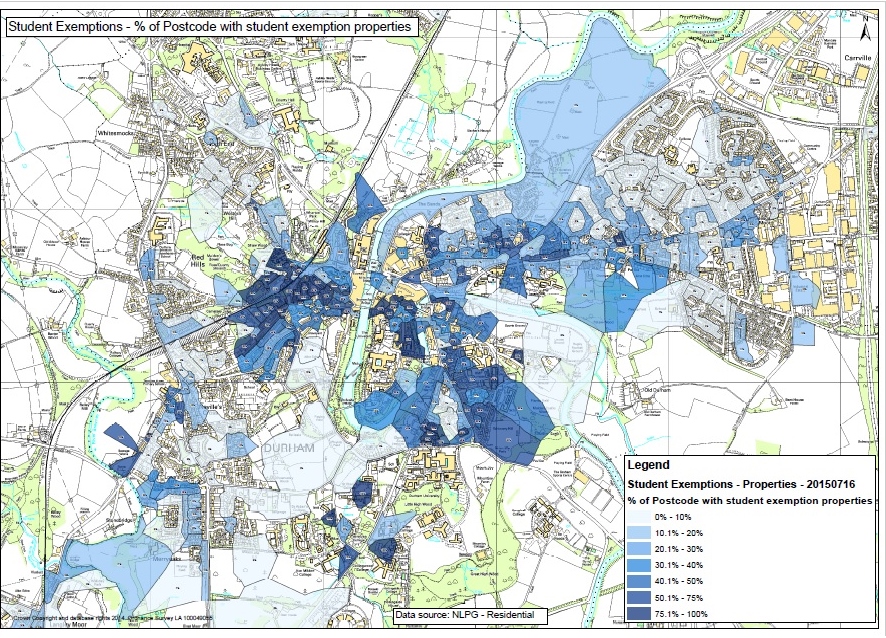Policy D3: Student Accommodation in Houses in Multiple Occupation (HMO)
In order to promote the creation of sustainable, inclusive and mixed communities and maintain an appropriate housing mix, development proposals for new build Houses in Multiple Occupation (both C4 and sui generis), extensions that result in additional bed-spaces, and changes of use from any use to:
- a Class C4 (House in Multiple Occupation), where planning permission is required; or
- a House in Multiple Occupation in a sui generis use (more than six people sharing)
will not be permitted if:
- including the proposed development, more than 10% of the total number of residential units including those in Purpose Built Student Accommodation within 100 metres of the application site are already in use as HMOs or student accommodation exempt from council tax charges;
- there are existing unimplemented permissions for Houses in Multiple Occupation within 100 metres of the application site which, in combination with the existing number of properties exempt from council tax charges, would exceed 10% of the total residential properties within the 100 metres radius; or
- less than 10% of the total residential properties within the 100 metres radius are exempt from council tax charges but the application site is in a residential area and on a street that is a primary access route between Purpose Built Student Accommodation and the town centre or a University campus
In all cases development proposals will only be permitted where:
- The quantity of cycle and car parking provided is in line with the Council’s adopted Parking and Accessibility Guidelines and Policies T2 and T3 of this Plan; and
- They provide acceptable arrangements for bin storage and other shared facilities and consider other amenity issues; and
- The design of the building or any extension would be appropriate in terms of the property itself and the character of the area; and
- The applicant has shown that the security of the building and its occupants has been considered along with that of other local residents and legitimate users.
Changes of use from an HMO to C3 will be supported. Opportunities to enable this will be explored as they arise in order to assist the re-balancing of neighbourhoods.
4.179 PBSAs comprise a number of cluster flats and/or self-contained flats. Each flat in a PBSA is counted as a residential unit.
4.180 The C3 planning use class covers dwellinghouses for up to six people living together as a single household. Enabling changes of use from an HMO to C3 will be a challenge as there is some evidence that students prefer HMO accommodation to PBSAs or college accommodation (Durham University, Geography Department, 2015)
Justification for Policies D2 and D3
4.181 Student accommodation in Durham City is one of the most frequently mentioned issues in the Plan’s consultations (Durham City Neighbourhood Planning Forum, 2015), and the subject of much debate over many years. Working in partnership with Durham University and residents’ groups, the County Council adopted an Interim Policy (Durham County Council, 2016d) to deal with applications to develop HMOs (houses in multiple occupation) and PBSAs (purpose built student accommodation) and this has proved to be reasonably effective. The emerging County Durham Local Plan proposes significant improvements in the light of experience. This is most welcome. The Neighbourhood Plan provides the opportunity to make minor but vital further improvements, and these are incorporated into Policies D2 and D3 in order to enable the number of student accommodation units within a PBSA to be counted towards the threshold rather than the whole PBSA simply to be counted as one property.
4.182 The over-riding consideration within these policies on whether additional HMOs or PBSAs are acceptable is the objective in the NPPF (para. 62) of creating mixed and balanced communities. The context section above explains how ‘studentification’ can be and has been damaging to community harmony and balance. Whilst the proposed policy D3 on HMOs sets a clear threshold for resisting further HMOs, it is recognised that individual cases of personal circumstances will be additional considerations in deciding on particular cases.
Map 7: Studentification
Note: Map supplied by Durham County Council
 4.183 Implementation of the interim policy and its successor depends for HMOs (houses in multiple occupation) upon the introduction of an Article 4 Direction to remove certain householder development rights within a prescribed part of the City. Such a Direction was approved for a large part of the centre of the City and came into force on 17th September 2016. A further Direction for much of Framwellgate and Newton Hall came into force on 17th May 2017. In order to be able to resist the overspilling of HMO developments into the rest of Our Neighbourhood, a third Direction to cover the remaining part of this area would be needed. This is an action which will be for the County Council to take forward. Similarly, an Article 7 Direction to control letting boards across Our Neighbourhood is the responsibility of the County Council who carried out a public consultation in early 2017 and is now proceeding through the statutory procedures for adoption, hopefully in 2019/20.
4.183 Implementation of the interim policy and its successor depends for HMOs (houses in multiple occupation) upon the introduction of an Article 4 Direction to remove certain householder development rights within a prescribed part of the City. Such a Direction was approved for a large part of the centre of the City and came into force on 17th September 2016. A further Direction for much of Framwellgate and Newton Hall came into force on 17th May 2017. In order to be able to resist the overspilling of HMO developments into the rest of Our Neighbourhood, a third Direction to cover the remaining part of this area would be needed. This is an action which will be for the County Council to take forward. Similarly, an Article 7 Direction to control letting boards across Our Neighbourhood is the responsibility of the County Council who carried out a public consultation in early 2017 and is now proceeding through the statutory procedures for adoption, hopefully in 2019/20.
Next section: Policy D4: Housing for Older People and People with Disabilities



1 Responses to Policy D3 – 2019 version